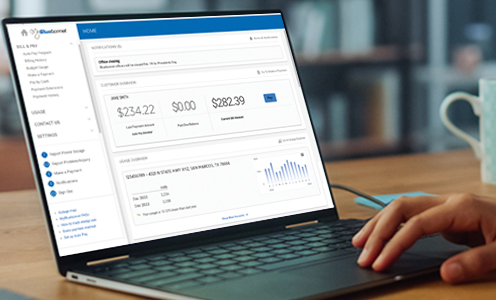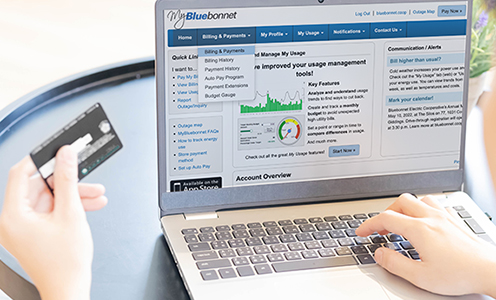First responders of the Bluebonnet region
Recent news
BY ED CROWELL
When Bluebonnet Electric Cooperative powered the first light bulbs in rural Central Texas in 1939, the World’s Fair in New York was unveiling an all-electric home with a dazzling kitchen, complete with a refrigerator, electric range, dishwasher, coffee maker, garbage disposal, food mixer and an automatic toaster.
To allow buyers in Texas and other states to get a close look at these life-changing devices, the federal Rural Electrification Administration outfitted a traveling show of circus tents filled with innovative home appliances. The caravan of dreams drew crowds by the thousands, and by the early 1940s, appliance sales were skyrocketing.
Wood-burning stoves, clothing washboards and heavy hand irons heated by a fire — all of which required backbreaking labor — were pushed aside for these conveniences of modern living.
The consumer race for electric appliances gained momentum as World War II ended in 1945. The post-war housing boom increased consumer demand for kitchen appliances as well as electric radios and then TVs.
By the 1950s, color televisions were available, though most popular TV shows aired in black-and-white until the late 1950s or early 1960s. General Electric made its household appliances pop by adding color such as Petal Pink and Canary Yellow (a design trend that may have influenced the future Apple CEO Steve Jobs in the late 1990s when he unveiled colorful “flavors” of the iMac personal desktop computer: blueberry, strawberry, lime, tangerine and grape).
At Bluebonnet’s then-headquarters in Giddings, electric appliances could be viewed and touched, just like in a retail showroom. Bluebonnet held appliance demonstrations in small towns and communities across its service area.
The 1960s and 1970s brought the ability to save substantial time on cooking. Microwaves, Crock-Pots and Mr. Coffee — the first automatic drip machine — were unveiled and embraced by consumers. Cuisinart food processors and hot-air popcorn poppers also made kitchen time less onerous.
Again, Bluebonnet took center stage to help consumers understand how all those new appliances could change lives. Bluebonnet hired Lavonne Morrow to demonstrate microwave cooking, and some events drew more than 100 eager learners. She shared recipes for microwave casseroles, three-minute fudge and even a tiny birthday cake baked in an ice cream cone. To consumers’ amazement, she showed how an entire meal for six people could be prepared and cooked in a microwave in just 30 to 45 minutes.
Clearly, electric appliances were changing American culture. The convenience of a microwave, washing machine or vacuum cleaner freed more time for work outside the home. Growing numbers of American women joined the workforce for a paycheck.
America turned its attention to the environment in the 1970s, as oil and gas supply crises brought long lines at the gas pumps and prompted President Jimmy Carter to ask Americans to save energy by turning thermostats to 65 or lower in the winter.
It’s no surprise that the 1980s and 1990s saw advances in energy efficiency in home appliances and a big turn toward automation. In 1992, the Environmental Protection Agency introduced the Energy Star program to promote the purchase of energy-efficient appliances.
Today’s digital age is bringing increasingly “smart” electronics into the home that merge internet connectivity with phones, computers, artificial intelligence devices and appliances. Alexa, the voice-activated virtual assistant in the Amazon Echo device, was unveiled in 2016, and 100 million had been sold by the end of 2018, according to the company. A seemingly endless stream of other new devices can connect with the Echo or its top competitor, Google Home. Virtual assistants can turn on and off smart appliances and timers, stream music and read books to you, and each adds new skills regularly. A glut of smart security cameras that allow you to view the outside or inside of your home on your phone are popping up everywhere.
In the living room, consumers are making way for big-screen televisions with curved displays, screens that roll up and down and technology that illuminates every pixel in the screen. That means viewers can sit at any angle to the screen without a distorted image.
Some of today’s refrigerators have cameras inside to show whether you need to buy milk or eggs when you check from a smartphone while at the grocery store. Samsung’s $4,100 fridge also has a computer screen on the outside door for searching recipes, displaying family photos and keeping lists and calendars. GE’s new Kitchen Hub is a smart screen on a stove ventilation hood. It controls the thermostat and lights, security cameras, and other smart appliances. Users can stream movies and music and have video chats.
Or, there is always the option to just ignore all of these chatty, mind-boggling innovations.
Today’s refrigerators are a long way from the Giddings High School “home ec” classes that Shirley Hannes began teaching in 1961. She commanded four kitchen nooks filled with stoves, refrigerators, washers and dryers, all loaned by Bluebonnet. Hannes made certain her students knew how to use the latest in home appliances, some of which must have glowed in mid-century hues of Harvest Gold and Avocado.
Hannes, who now lives south of Houston in Pearland, doesn’t want a virtual assistant like Alexa, but she loves the two-door refrigerator she bought in 2018 because it makes and dispenses ice.
She’s not one to replace appliances just to have the newest model. “We built our house in 1976, and the stove was new then,” she said. “It’s still in good shape, so I’m not planning to replace it yet.”
By Mary Ann Roser and Melissa Segrest
Do you remember the friendly person dressed in a tan shirt who walked up your drive to your house every month? He or she peered at your electric meter, decoding its dials, numbers and circling arrows. The person quickly typed numbers into a curious black device and then left, only to return the next month.
They were Bluebonnet Electric Cooperative’s meter readers, the human point of contact for thousands of co-op members every month. They worked from 1985 until 2007, when the cooperative fully converted to automated electric meters that use power lines to transmit power consumption information directly to Bluebonnet’s system.
After the conversion, many meter readers stayed on with Bluebonnet. Several dozen still work at the co-op, holding various jobs, from line workers to crew supervisors, control room operators to line construction planners.
“That was the cool thing about it,” said Kyle Boer, Bluebonnet’s superintendent of engineering services. “All of our meter readers were exceptionally loyal, and we didn’t want to lay anybody off.”
This year, Bluebonnet is celebrating its 80th anniversary. With auspicious timing, in April the cooperative topped the 100,000 meter mark, which establishes it as one of the largest electric co-ops in the nation. Today’s electric meters are state of the art, and new versions are replacing older meters. In 2018, 4,000 of them were installed, and this year, crews plan to replace another 3,000 older meters.
BACK IN THE DAY
Before meter readers, Bluebonnet members read their own electric meters and wrote down how much electricity they used on cards that were sent to the cooperative.
“It was an honor system,” said James Jordan, who runs the meter distribution shop at the cooperative’s Giddings service center. He has worked at Bluebonnet for 23 years. If a member’s consumption numbers looked a little suspicious, an employee would stop by and check the meter.
In the early 1970s, Bluebonnet had far fewer meters across its 3,800-square-mile service area and almost all of those were residential, said Donnie Graham of Lockhart, a former supervisor of meter readers who retired in 2005. At that time, the co-op staff was so small that after 5 p.m. and on weekends, Graham said he would just transfer calls about power outages to his home phone.
By the end of the meter-reading era, the cooperative had dozens of meter readers, each trying to read at least 100 meters a day. Although meter readers had radios to communicate with supervisors, they relied on paper maps in large bound volumes, looking for dots that pinpointed meter locations.
Reaching a meter wasn’t just a stroll up a driveway. Sometimes, a meter reader had to drive a mile, go through multiple locked gates and make a long trek on foot just to reach a single meter. They carried heavy rings of 50 or more keys to unlock gates on members’ property to access meters.
Philip Grimm recalled how rain and mud could make roads impassable for their two-wheel drive trucks. Many meter readers carried long lengths of chain for the inevitable stuck-in-a-rut moment. Driving through oil fields and muddy roads with only AM radio and no air conditioning was a challenge. Grimm gets to be pickier about Bluebonnet’s vehicles today: He is the cooperative’s fleet supervisor.
“We were very rough on trucks,” said Carla Bates, a former meter reader still working with Bluebonnet.
Bates first read meters for a contractor, then as a Bluebonnet employee starting in 1999. Today she helps plot the locations of poles, lines, equipment and meters for new homes of new cooperative members. That job is important, but “when we were the meter readers, we were the most important people at Bluebonnet,” she said with a grin.
THE HUMAN TOUCH
Some Bluebonnet members loved to see the meter readers. Others made it clear they didn’t want them on their property.
“Almost all of our members – 99.9 percent – were, and are, really great people,” said Boer, who has worked more than three decades.
Doug Schlemmer was a Bluebonnet meter reader for years. Today he is a crew supervisor out of the Giddings service center. He remembers receiving holiday cookies from members and having long conversations with members who rarely had visitors. One older man always offered a Dr Pepper. Another man refused to pay his monthly bill until someone came to his house, when he would gladly pay a late fee for the chance to chat.
It was no surprise that many Bluebonnet members, especially the seniors, were sad to learn meter readers would no
Sometimes meter readers noticed problems: a gate that had been cut, a house that had been broken into, a big water leak. They fixed the occasional flat tire for a member or helped an older couple move furniture.
But the job was not all cookies and compliments. Some ornery members locked out the meter readers or refused to provide gate lock combinations. No one recalls being hurt by an annoyed member, despite the occasional threat and drawn gun.
A few members went to great lengths attempting to tamper with their meters to try and avoid paying bills – which was, and still is, illegal.
LIONS, TIGERS AND DOGS
Animals and insects posed the biggest problems for meter readers. Most agreed their scariest encounters were with dogs. Even with dog treats, distraction tactics, sprays, “bad dog” warnings, requests for help from dog owners and the occasional stick as a defensive weapon, there were a few dog bites but mostly near misses.
Marti Wright, now superintendent of contractor operations, kept a large bag of dog treats in her truck and always had some handy in her pocket. She said that if a dog was chasing her, one of her strategies was to toss a few treats as a distraction to allow her to jump back into the truck.
Bees, wasps and spiders caused problems, too. Bates once reached over a fence and was bitten by a black widow spider. Occasionally, meter readers were chased by surly geese and turkeys, too.
And yes, there really was a lion, a tiger and a panther, according to Schlemmer. They lived on property near Birch Creek. Schlemmer will never forget one big cat that tried to sneak up on him. He heard the unmistakable hiss of a cougar hot on his heels and barely escaped an attack, even though the big cat was chained.
On that day, the promise of high-tech automated meters never seemed so good.
VIEW AN ELECTRIC METER TIMELINE





